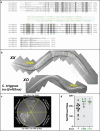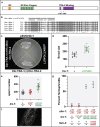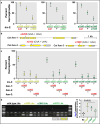Rewiring the Sex-Determination Pathway During the Evolution of Self-Fertility
- PMID: 38880992
- PMCID: PMC11180601
- DOI: 10.1093/molbev/msae101
Rewiring the Sex-Determination Pathway During the Evolution of Self-Fertility
Abstract
Although evolution is driven by changes in how regulatory pathways control development, we know little about the molecular details underlying these transitions. The TRA-2 domain that mediates contact with TRA-1 is conserved in Caenorhabditis. By comparing the interaction of these proteins in two species, we identified a striking change in how sexual development is controlled. Identical mutations in this domain promote oogenesis in Caenorhabditis elegans but promote spermatogenesis in Caenorhabditis briggsae. Furthermore, the effects of these mutations involve the male-promoting gene fem-3 in C. elegans but are independent of fem-3 in C. briggsae. Finally, reciprocal mutations in these genes show that C. briggsae TRA-2 binds TRA-1 to prevent expression of spermatogenesis regulators. By contrast, in C. elegans TRA-1 sequesters TRA-2 in the germ line, allowing FEM-3 to initiate spermatogenesis. Thus, we propose that the flow of information within the sex determination pathway has switched directions during evolution. This result has important implications for how evolutionary change can occur.
Keywords: evolution of gene regulation; nematodes; sex determination.
Published by Oxford University Press on behalf of Society for Molecular Biology and Evolution 2024.
Figures






Similar articles
-
A sensitized genetic background reveals evolution near the terminus of the Caenorhabditis germline sex determination pathway.Evol Dev. 2009 Jul-Aug;11(4):333-42. doi: 10.1111/j.1525-142X.2009.00340.x. Evol Dev. 2009. PMID: 19601967 Free PMC article.
-
fog-2 and the evolution of self-fertile hermaphroditism in Caenorhabditis.PLoS Biol. 2005 Jan;3(1):e6. doi: 10.1371/journal.pbio.0030006. Epub 2004 Dec 28. PLoS Biol. 2005. PMID: 15630478 Free PMC article.
-
Independent recruitments of a translational regulator in the evolution of self-fertile nematodes.Proc Natl Acad Sci U S A. 2011 Dec 6;108(49):19672-7. doi: 10.1073/pnas.1108068108. Epub 2011 Nov 21. Proc Natl Acad Sci U S A. 2011. PMID: 22106259 Free PMC article.
-
Sex determination in the germ line.WormBook. 2007 Mar 5:1-13. doi: 10.1895/wormbook.1.82.2. WormBook. 2007. PMID: 18050498 Free PMC article. Review.
-
RNA and sex determination in Caenorhabditis elegans. Post-transcriptional regulation of the sex-determining tra-2 and fem-3 mRNAs in the Caenorhabditis elegans hermaphrodite.EMBO Rep. 2001 Oct;2(10):899-904. doi: 10.1093/embo-reports/kve209. EMBO Rep. 2001. PMID: 11600454 Free PMC article. Review.
Cited by
-
F-box proteins at the crossroads of ubiquitination and tumor immunity: regulatory networks and immunotherapy strategies.Front Immunol. 2025 Jun 4;16:1596344. doi: 10.3389/fimmu.2025.1596344. eCollection 2025. Front Immunol. 2025. PMID: 40534867 Free PMC article. Review.
-
Balancing selfing and outcrossing: the genetics and cell biology of nematodes with three sexual morphs.Genetics. 2025 Feb 5;229(2):iyae173. doi: 10.1093/genetics/iyae173. Genetics. 2025. PMID: 39548861 Free PMC article. Review.
-
Robust sex determination in the Caenorhabditis nigoni germ line.Genetics. 2025 Apr 17;229(4):iyae207. doi: 10.1093/genetics/iyae207. Genetics. 2025. PMID: 39663849 Free PMC article.
References
MeSH terms
Substances
Grants and funding
LinkOut - more resources
Full Text Sources
Miscellaneous

